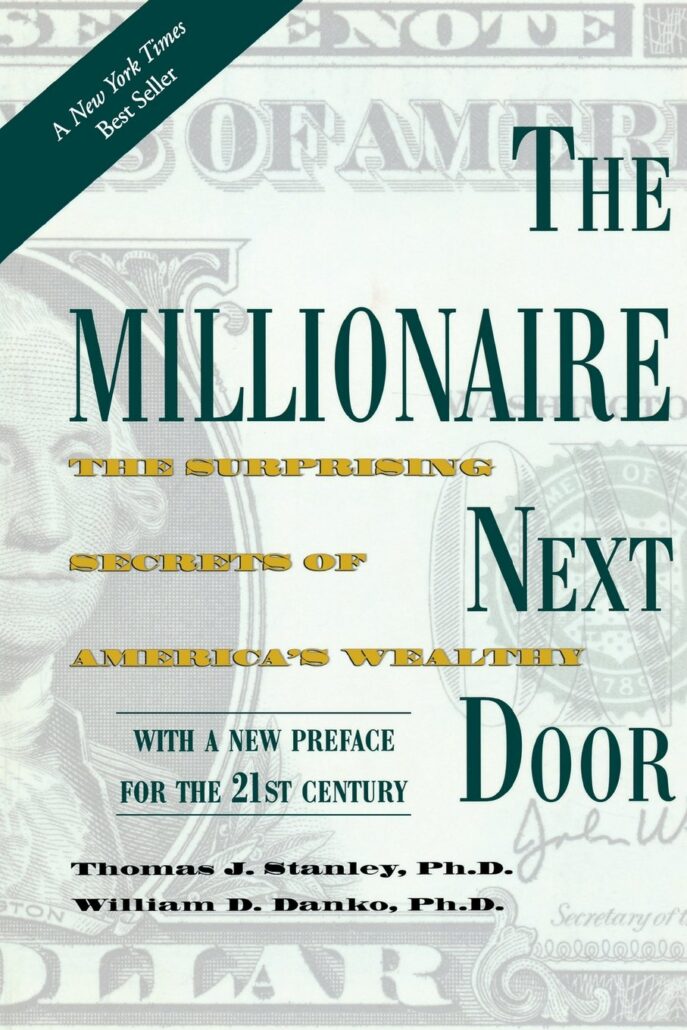The Millionaire Next Door: The Surprising Secrets of America’s Wealthy
Author: Thomas J. Stanley and William D Danko
Genre: Entrepreneurship and Wealth Creation

Thomas J Stanley was an American writer, professor & a business theorist. He wrote The Millionaire Next Door and The Millionaire Mind which were on New York’s bestseller for more than 170 weeks. Prof. William D Danko, the co-author of this book, is an expert on marketing and behaviour of the affluent.
Millionaire Next Door was published in 1996 and still teaches how a person can become that next door millionaire in one generation without wealth inheritance. The authors have done extensive research and interviewed 100s of people living with net worth of US$1-$10 million. Contrary to belief that millionaires exist mainly in affluent, white-collar professions, they found out that millionaires exist even amongst middle-class, blue-collar professionals. Millionaires don’t really live the life as portrayed in show biz with all the glitz and glamour. Rather, they spend more time budgeting their expenses, investments, and focussing on wealth creation. The book teaches how individuals can become millionaires by using simple rules on everyday basis and planning one’s finances. Most millionaires interviewed in the book don’t spend money on luxury items but instead focus on securing their future. The key is to become financially independent by saving to a point where we can live our life the way we are living today, even post our retirement.

The book provides readers a simple thumb rule to determine if you are wealthy: Multiply your age times your realised pre-tax household income from all sources (but leaving inheritance aside). Divide by Ten. The answer is what your net worth should be. Say you are 40 and earn $250k per year pre-tax, we should have $1m savings today (net of any home and other loans).
Prospective millionaires allocate their time, energy and money efficiently in ways conducive to building wealth. The book gives many methods to do it in the right way for e.g., hours spent in planning financial investments, planning and controlling consumption, car shopping methods, taxes, external factors etc.

Next the book talks about believing in being financial independent rather than in displaying high social status. Living a modest life. For instance, authors cite very detailed examples of buying vs. leasing a car, either a new or used vehicle but not buying a Rolls-Royce, buying within a budget which will not hamper one’s wealth and so on. So we have to become frugal and ‘deal shopper’ rather being a dealer loyalist.
Very critical is to make our kids economically self-sufficient. Giving them pocket money and teaching them how to effectively use it and save from it. Authors, through their research, also got to know certain rules which affluent parents use to raise their children:
- Never tell children that their parents are wealthy.
- No matter how wealthy you are, teach your children discipline and frugality.
- Assure that your children won’t realise you are affluent until after they have established a mature, disciplined, and adult lifestyle and profession.
- Minimize discussions of the items that each child will inherit or receive as gifts.
- Never give cash or other significant gifts to your adult children as part of a negotiation strategy.
- Stay out of your adult children’s family matters.
- Don’t try to compete with your children.
- Always remember that your children are individuals.
- Emphasise your children’s achievements, no matter how small, not their or your symbols of success.
- Tell your children that there are a lot of things more valuable than money.
Who are the affluent? The authors’ research says that most of the affluent are business owners, including self- employed professionals. Also, one can never predict if someone is millionaire by the type of business he is in. The character of the business owner is more important in predicting the level of wealth than the classification of his business. The authors also suggest that the so called normal-dull businesses actually have steady earnings growth which, in the long term, make best investments.
Towards the end, the book again talks about the two groups – UAWs (under accumulators of wealth) and PAWs (prodigious accumulators of wealth) – and their distinct needs. The PAWs need to achieve, to create wealth, to become financially independent, to build something from scratch. UAWs more often need to display a high-status lifestyle. They are basically high earners but high spenders too. But what happens when members of these 2 groups attempt to occupy the same space at the same time? A detailed case study in the book gives an insight. While the lessons of the book make intuitive sense, it keeps harping on living below your means. Most of the people who want to become a millionaire would also want to upgrade their quality of life whereas this book will tell you to be frugal and save more.
Why should you read this book: This book acts as a personal guide to becoming a millionaire. The book offers great ideas and a promising path to becoming one by doing careful savings, long-term investments, and making the right lifestyle choices.
Goodreads Link: The Millionaire Next Door: The Surprising Secrets of America’s Wealthy by Thomas J. Stanley (goodreads.com)

 This information will never be shared with third party
This information will never be shared with third party
Post A Comment
Want to join the discussion?Feel free to contribute!